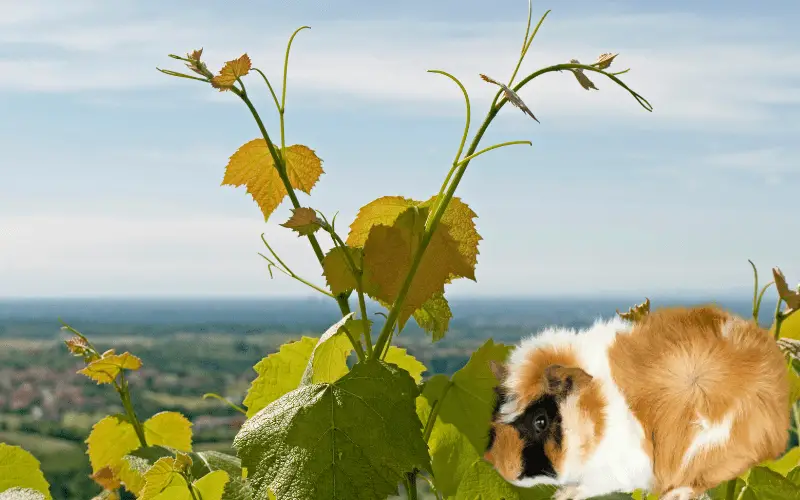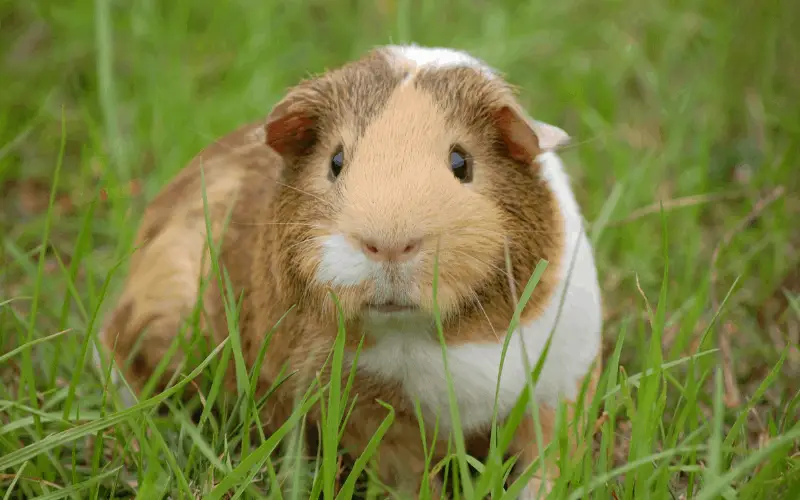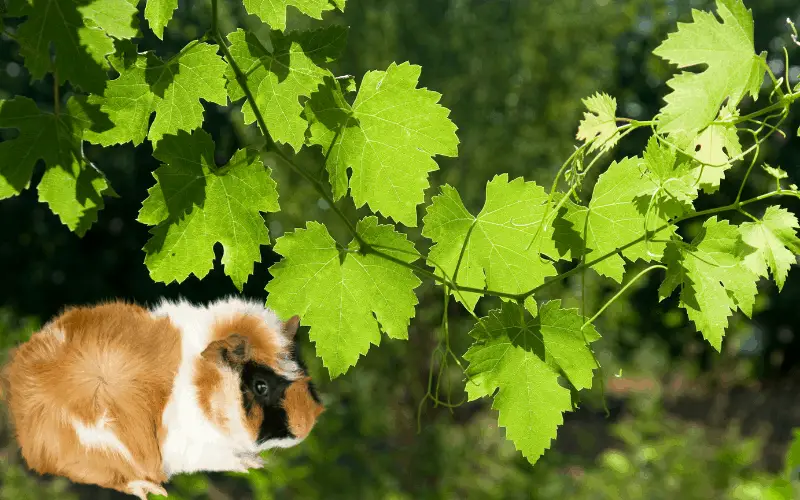Can guinea pigs eat grape vine leaves? While enough research has not been done regarding the safeness of grapevine leaves for guinea pigs, most people recommend not feeding your guinea pig with grapevines.
Guinea pigs have very sensitive stomachs and you do not want to put your pet through some kind of gastrointestinal troubles. However, you can feed grapes to your guinea pig in small portions, it is perfectly safe for them.
Can Guinea Pigs Eat Grape Vine Leaves?
There’s really not a concrete answer to this question as there’s no known study to prove whether guinea pigs can eat grape vine leaves, so we won’t advise you to feed your piggies with grapevine leaves.
Remember to always be very mindful of what you feed your guinea pigs due to their sensitive stomachs. A little mistake in their diet could lead to a serious issue. But there are still some types of grapes that guinea pigs can eat.
Let’s look at them below:
Types Of Grapes You Can Feed Your Guinea Pigs

There are over ten thousand vine grape varieties are available around the world. But it possibly can’t be safe to feed your guinea pig every type of grape you can lay your hands on.
Some grapes contain seeds and some do not, it is recommended to feed your guinea pig the ones that are seedless.
Here is the list of the most common grapes you can find in most grocery stores, which are safe to feed your guinea pig.
- Red seedless grapes
- Red grapes
- Green seedless grapes
- Green grapes
- Black seedless grapes
- Black grapes
- Cotton candy grapes
All these types of grapes are safe to feed your guinea pig, but you need to ensure that there are no seeds inside the grapes, and the pieces of the fruit are not cut too big.
Feeding Your Guinea Pigs Grapes
There are different types of grape with colors ranging from dark blue, red, yellow, pink, green, orange, dark blue, to black. Grapes are juicy, sweet, and have high vitamin C content.
It’s okay to be scared about feeding grapes to your pet if you don’t know as many fruits that seem perfect are known to be toxic to several animals. So if you are wondering can guinea pigs eat grapes? The answer is quite simple.
Guinea pigs can safely eat grapes, but shouldn’t be fed your guinea pig daily. Grapes have very high sugar content so your guinea pigs will enjoy eating them but it can lead to obesity and other complications for your guinea pig.
So although grapes provide vitamin C, they are low in calcium compared to phosphorus which can cause kidney stones in guinea pigs.
Parts Of A Grape That Is Edible For A Guinea Pig
Grape has three edible components that you can feed your guinea pig:
- Flesh
- Seeds
- Skin
When offered any of these components, a guinea pig will happily eat all of them but is it safe for your guinea pig
1. Grape Seeds
There is nothing harmful in grape seeds so it can be feed to your guinea pigs. However, grape seeds could form a choking hazard.
That is why it is recommended to only feed seedless grapes to your pet instead of trying to pick out the seeds yourself!
2. Grape Skin
Grape skins contain fiber, which is good for guinea pigs to eat. But sometimes a fruit skin may be exposed to pesticides. This is why you should try to give a guinea pig organic grapes that are free from pesticides and other nasty chemicals.
If you can’t find organic grapes, ensure to thoroughly scrub the grapes before feeding them to your guinea pig.
3. Grape Flesh
The flesh of grapes is safe for guinea pigs to eat. But It is recommended to only feed your guinea pig a few grapes as an occasional treat once or twice a week maximum.
This is because grapes contain more phosphorus than calcium which can cause the development of kidney and bladder stones in guinea pigs.
When the content of phosphorus is higher than calcium, the two bind to form hard deposits or stones. These then collects in a guinea pig’s kidneys.
From the kidneys, the stones can travel to a guinea pig’s bladder where they can cause infections and blockages in its urinary tract, this usually requires a risky surgery to remove them.
But feeding them grapes only occasionally will help to prevent such from happening
Advantages & Disadvantages Of Feeding Your Guinea Pigs Grapes
Although grapes are quite healthy, and also a low-calorie fruit, they have high sugar contents for a guinea pig, this makes them readily devour it when offered. Here are some of the pros and cons associated with feeding guinea pigs grapes.
Pros Of Feeding Grapes To A Guinea Pigs Diet
Grapes have high vitamin C content which guinea pigs need for growth, development, and tissue repair. They also have a high water content which helps to keep your guinea pig hydrated.
Grapes also contain fiber which is great for a guinea pig’s digestive health. Fiber is needed by a guinea pig in order to maintain the balance of the healthy bacteria present in a guinea pig’s gut and it also stimulates gastrointestinal motility which aids bowel movement!
Cons Of Feeding Guinea Pigs Grapes
Guinea pigs have very small body mass so every calorie count. This means it is very easy for a guinea pig to easily gain weight.
Fruits like grapes contain naturally-occurring sugar which has just as many calories as the sugar you sweeten your drinks with.
So feeding too much of such an item to your guinea pig can cause it to become overweight and obese!
Also as stated earlier, grapes have a high content of phosphorus which can cause kidney stones to develop if it is fed to guinea pigs too often.
Right Amount Of Grapes To Feed A Guinea Pigs
The number of grapes you feed to your guinea pigs should be strictly monitored. They should be offered more as a sweet treat for guinea pigs.
Grapes do not offer lots of Vitamins and minerals but at the same time, they are essential for bringing a change in taste in your guinea pig’s diet. Your guinea pigs should not be fed more than 1-2 medium size grapes. And it should be fed not more than once a week.
Grapes should be served as a treat to guinea pigs and should not be an integral part of their diet. You can also feed your pig other nutritional fruits like apple and strawberry instead of grapes.
Grapes have a charming, demanding personality and will enjoy munching on your grapes, this can make you tempted to feed them with more grapes but you shouldn’t.
You must keep your emotions in control and only feed them with what is right. Overfeeding your guinea pig is very easy when it comes to grapes.
Can You Feed Your Guinea Pigs Grapes With Seeds?

No, you should not feed grapes with seeds to your Guinea pigs as they have very delicate digestive and body systems.
How To Prepare Grapes For Your Guinea Pig
In order for your pet to achieve the most nutrition out of food, you must learn to serve them in the right way. Here is the right way to prepare grapes for your guinea pigs.
The first thing to do is choosing the right grapes. You should only feed your guinea pigs with ripe and fresh grapes. Feeding your pet rotten and unripe grapes can cause serious digestive diseases.
The next step is to thoroughly wash the grapes. It is because grapes are often sprayed with pesticides. So you need to ensure you wash away every bit of chemicals from them the grapes before you feed them to your guinea pigs.
Next, you should cut the grapes in half and remove the seed (if you are using grapes with seeds). You should ensure you remove the seed from all the grapes before offering it to your guinea pigs.
Then finally, serve them the grapes either by hand feeding or in a small food bowl. Ensure you remove any uneaten grape or its residue from your pet’s cage to prevent any bacteria buildup.
Fruits You Can Offer Your Guinea Pig As Treats
Offering fruit to guinea pigs is a great way to provide them with their vitamin and mineral needs. Providing your piggies with fibrous fruits is great for their digestive health.
The ideal fruits to feed your guinea pig should be:
- Low sugar
- High fiber
- Lower phosphorus content than calcium
- High vitamins and minerals
There is a list of different fruits you can feed your guinea pig, but you should do so carefully as the majority of fruits have more phosphorus than calcium which could cause health problems to your guinea pigs.
So, a guinea pig should not eat fruits of any variety daily, they should only be fed only a small portion of fruit once a week
Fruits Guinea pigs can safely eat:
- Apple
- Apricot
- Banana
- Blueberries
- Cherries
- Cranberries
- Kiwi
- Mango
- Melons of any variety
- Nectarine
- Papaya
- Passionfruit
- Peach
- Pear
- Pineapple
- Raspberries
- Strawberries
Out of the different fruits listed above, the ones with the lowest sugar content are raspberries and strawberries which makes them slightly better for guinea pigs but still, they shouldn’t be fed to guinea pigs regularly.
What Else Can Guinea Pigs Eat?
If you are looking for more information, walkthroughs and troubleshooting about Guinea Pigs and their diet, here are some additional posts you can check out:
Before feeding any type of fruit to a guinea pig, you need to make sure it is organic. If it isn’t, you need to thoroughly wash the fruit to remove any pesticide residues before feeding it to your pet.
Conclusion
Guinea pigs love grapes, and they will eat them in a heartbeat. However, grape is not a food item that should be fed to your guinea pig regularly due to its high sugar amount.
Aside from the grapefruit itself, there are other parts of the grape that might be harmful to your guinea pig and shouldn’t be offered to it, one of these is the grapevine leaves.
So if you have been wondering can guinea pigs eat grapevine leaves? Although it is not recommended, there’s no proof of its effect on guinea pigs.

